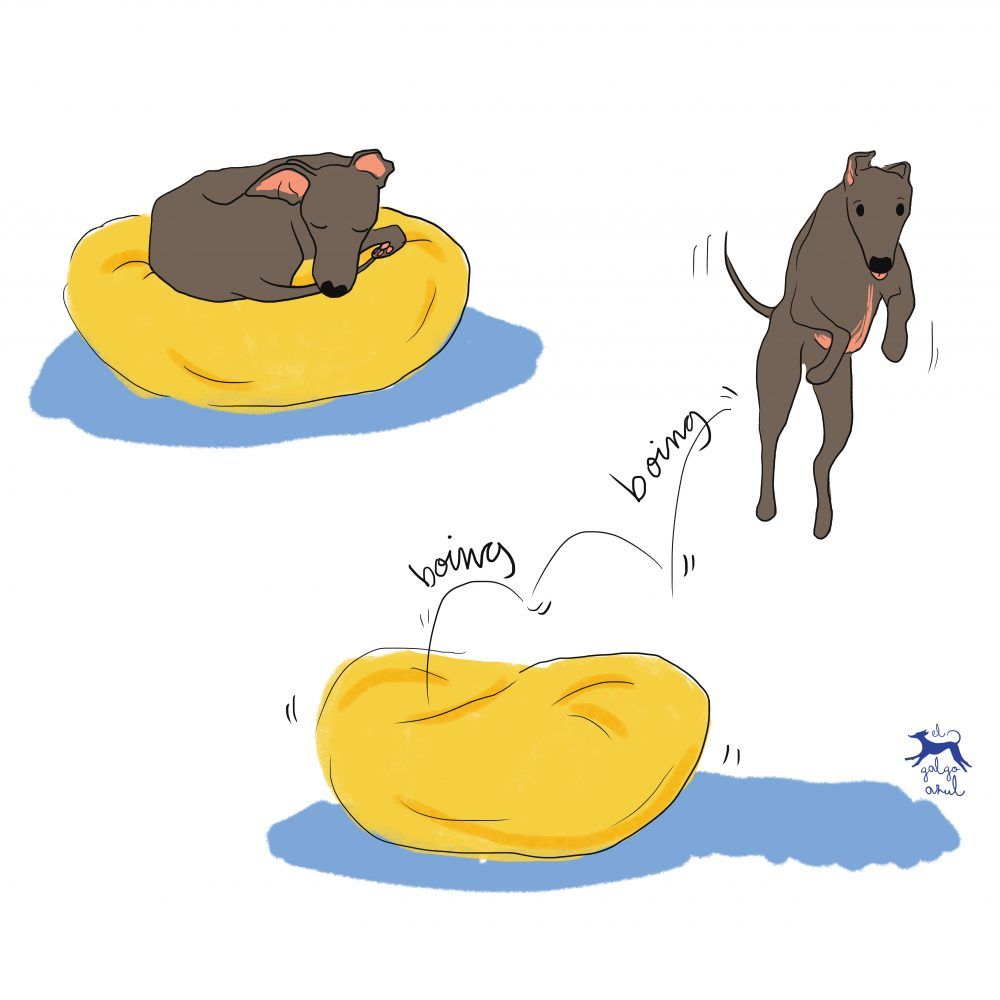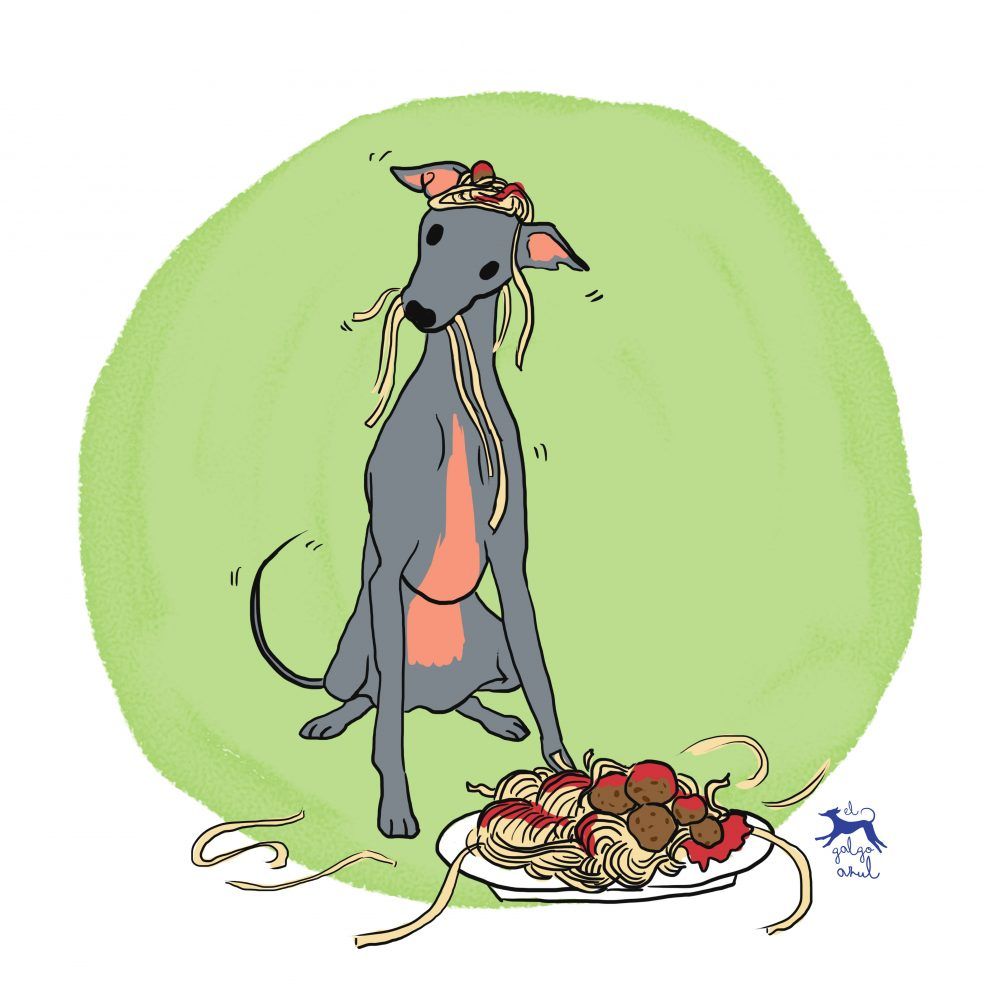Elegance became art with the Italian hound and it is that few races can be proud of having been the inspiration of artists of all times, from Classical Greece to the brushes of great Renaissance men like Giotto. Its reflection in art shows the importance of this greyhound among the European aristocracy, who made it the smallest version of sighthounds.
Despite be on the brink of extinction twice, this little hunter is a lucky one among greyhounds. The Italian greyhound earned his survival in time more than by hunting hares, for having conquered a good corner in the triclinium (Roman divan) to nap free.

ORIGIN AND HISTORY OF THE ITALIAN Greyhound
The oldest known remains of a dog similar to today's Italian greyhound have been found in a Egyptian tomb of more than 6,000 years old, being a sign of its presence and importance in the Court of the Pharaohs. This ancestor too expanded into ancient Greece and Turkey, being represented in various decorative arts such as vases and vessels.
His arrival in present-day Italy occurred in the 5th century BCE. and they exist two theories that explain how it came about. The first indicates that they were the Phoenicians those responsible for its introduction into Roman territory from Greece and Turkey, while the second considers that they were the Roman soldiers who carried the greyhound with them when they returned home after military campaigns. Be that as it may, became the favorites of the patricians, who developed two types: a larger one for hare hunting and a smaller and more delicate one that became a companion dog.
During the Middle Ages the race began its expansion across the Mediterranean basin, but it wasn't until Renaissance when the further development of the breed as a companion dog. It reached such popularity among the Italian aristocrats during this period that was the origin of its name as "Italian greyhound or greyhound", becoming a common character in Italian Renaissance paintings.
His expansion by the European Courts reached its peak in the XVII century With the introduction of the breed to England by the monarch Carlos I. Thanks to this, the greyhound made a niche in the Courts of Denmark, Russia, Germany and Prussia, always maintaining its profile as a companion dog.
During the XIX century, the genetics of the Italian greyhound were impoverished due to the nobles' obsession with get a smaller and smaller dog to differentiate it from the whippet. Greyhounds became very fragile dogs with fertility problems and suffering from dwarfism, standing on the brink of extinction. However, to early 20th century breeders strove to recover the healthiest genetic lines of the breed.
Nonetheless, the breed faced another critical period in which it was about to become extinct again due to the devastation that had been the two World Wars in Europe. Fortunately, the Italian greyhound had come to the United States and Canada during the 19th century, from where specimens were imported to the old continent to cleanse and revive the impoverished European racial lines.
Today, Italian Greyhounds maintain their status as companion dogs, unlike other greyhound breeds that continue to be exploited as hunting or racing dogs. Thanks to their small size and extremely affectionate character, they have become one of the most popular sighthounds in the world.
PHYSICAL CHARACTERISTICS OF THE ITALIAN Greyhound
The official standard for the Italian Greyhound was established by the International Cynological Federation in 2010. Classified in group 10 section 3 as short-haired sighthounds, their physical characteristics are:


- Hope of lifetime: between 12 and 15 years.
- Size: small.
- Height: between 32 and 38 cm.
- Weight: maximum of 5kg.
- Complexion: slim.
- Extremities: long with fine musculature.
- Eyes: large, rounded and expressive with dark colored irises and pigmentation on the edge of the eyelids.
- Ears: tall, small, folded in on itself and facing backwards.
- Snout: narrow with a dark-colored nose and wide open nostrils.
- Jaws: strong and elongated with scissor bite.
- Neck: long and muscular with the throat line slightly convex and the nape slightly arched and bulging at the base.
- Line: long, low and fine, straight in the first half and bends at the tip.
- Hair: satin, fine and smooth.
- Coat colors:
- Black, gray and Elizabethan in all its shades.
- Any of the above with white on the sill and feet.
The Italian Greyhound is the smallest of all the Greyhound breeds, the result of selective breeding carried out in recent centuries. They are a miniature version of their other sister races, maintaining their physical characteristics. For this reason, Italian Greyhounds will be the smallest, but They are the fastest of the rest of the breeds of small dogs, reaching the 40 km per hour in the middle of the race.
CHARACTER OF THE ITALIAN Greyhound
The Italian Greyhound is a tremendously affectionate, calm and reserved dog. During the puppy stage, he is very happy and active, his character relaxing as he grows, but without losing that playful puppy spirit.
It is a very familiar and homely breed, but tends to create a special bond with a particular family member, to whom he will request the greatest attention and affection. Due to this characteristic, as an adult it can be shown indifferent and even fearful of strangers, so their socialization should not be neglected during their development.
Italian Greyhounds they are very intelligent dogs and learn very quickly, but never through traditional methods that make use of active punishment. It is important to keep in mind that greyhounds they are very sensitive dogs and they can easily enter learned helplessness if punishments are used as part of their education. The learned helplessness supposes a blockage for the animal, which ceases to show behaviors due to the fear of being punished again.
Despite having been bred as a companion dog, the instinct of hunting small prey on the move and physical barriers are not usually an impediment thanks to its great jumping ability. As it is very difficult for a dog to attend to your command when it has entered instinct, you must avoid the circumstances that can activate it if you walk it loose.
Italian Greyhounds are calm dogs, but with explosive energy They are good greyhounds, so their ideal exercise routine would be to take a half-hour walk with a few minutes of running. And given their physical characteristics, they work very well on agility circuits, where they get very good results.


ITALIAN Greyhound DISEASES
The Italian Greyhound can be affected by a series of pathologies more frequent in their racial group:
- Hip dysplasia.
- Patella luxation.
- Perthes disease.
- Von Willebrand disease.
- Hypothyroidism
- Allergies
- Progressive retinal atrophy.
- Vitreous degeneration.
- Waterfalls.
- Cryptorchidism.
- Epilepsy.
- Problems derived from the lack of bone density in dogs under 18 months of age such as fractures, fissures and dislocations.
CARE OF THE ITALIAN Greyhound
The Italian Greyhound does not require great care being a short-haired dog. A basic hygiene and take care of your hair health during shedding periods.
This breed is characterized by a very fast growth of nails, For this reason, special attention must be paid to their care to avoid fissures, breaks or plantar deformations derived from excessive growth. Special attention must also be paid to their dental hygiene because they are prone to tartar.
As mentioned in the previous point, special care must be taken with greyhounds under 18 months of age due to lack of bone density in the skeleton during its development. During this stage the greyhound should be prevented from playing with dogs that have greater physical power or with young children who still do not know how to treat dogs with care. The legs are the main affected and can be broken with a bad jump, running or by a blow.
It should also be noted that it is not a breed that is friendly to cold or rainy climates, so it is highly recommended that they be provided with the necessary shelter, both at home and during walks: blankets, stoves, coats, fleeces and raincoats.
As with other dogs, it must visit the vet regularly for your vaccination, deworming and health checks. You should also maintain a stable routine of daily walks and feeding.
YOU AND YOUR ITALIAN Greyhound
Are you one of the lucky ones who shares your couch with an Italian Greyhound? Well, don't wait any longer to share your experience with us. Go ahead and leave us a comment telling us your story. We can't wait to meet her!






